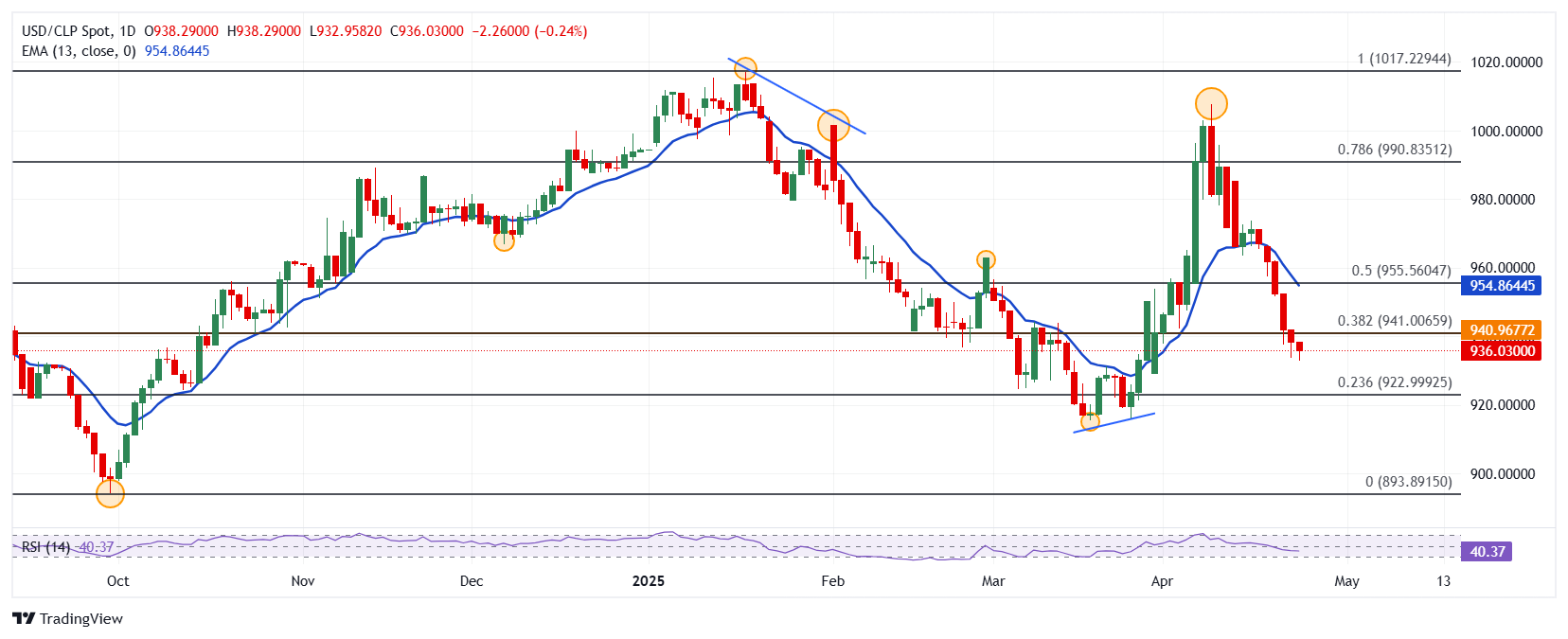- The US dollar falls against Chilean peso, operating the time to write about 936.38.
- The dollar index (DXY) rebounds 0.41% on Friday, oscillating within the previous session range at 99.70.
- Copper prices fall 1.52% in the day, reaching minimum of April 22 in $ 4,7157 per pound.
- China’s Ministry of Foreign Affairs clarified that they are not having tariff negotiations with the United States, increasing commercial tensions between the two countries.
- The Central Bank of Chile will announce its interest rate decision, on April 29.
The USD/CLP established a maximum of 938.29, attracting vendors that dragged the parity at minimum of March 31 in 932.95. Currently, the USD/CLP loses 0.20% on the last day of the week, currently quoting in 936.38.
Chilean weight is strengthened in the midst of tariff uncertainty
The president of the United States, Donald Trump, mentioned Thursday that supply was in commercial conversations with China, promoting the share market.
However, China’s Foreign Minister said today that he is not in negotiations or consultations in relation to US tariffs, increasing commercial uncertainty between the two countries.
In this context, the dollar index (DXY) rises 0.41% today, quoting within the operational range of Thursday’s session at 99.70.
On the other hand, Chile’s economic agenda contemplates the publication of the unemployment rate next Tuesday, April 29, which reached 8.4% in February. Similarly, the Central Bank of Chile will announce its interest rate decision, where consensus of analysts expects to remain unchanged by 5%.
In this scenario, the Chilean weight is listed up for the sixth consecutive day, while the USD/CLP loses 0.20 % % on Friday, consolidating at least three and a half weeks in 936.38.
Technical levels in the USD/CLP
The USD/CLP reacted down from a short -term resistance given by the maximum of April 9 in 1,007.73. The next important resistance is 1,017.05, maximum of January 17. To the south, the key support zone is located at 915.57, a pivot point of March 19.
USD/CLP daily graphics

US dollar FAQS
The US dollar (USD) is the official currency of the United States of America, and the “de facto” currency of a significant number of other countries where it is in circulation along with local tickets. According to data from 2022, it is the most negotiated currency in the world, with more than 88% of all global currency change operations, which is equivalent to an average of 6.6 billion dollars in daily transactions. After World War II, the USD took over the pound sterling as a world reserve currency.
The most important individual factor that influences the value of the US dollar is monetary policy, which is determined by the Federal Reserve (FED). The Fed has two mandates: to achieve price stability (control inflation) and promote full employment. Its main tool to achieve these two objectives is to adjust interest rates. When prices rise too quickly and inflation exceeds the 2% objective set by the Fed, it rises the types, which favors the price of the dollar. When inflation falls below 2% or the unemployment rate is too high, the Fed can lower interest rates, which weighs on the dollar.
In extreme situations, the Federal Reserve can also print more dollars and promulgate quantitative flexibility (QE). The QE is the process by which the Fed substantially increases the flow of credit in a stuck financial system. It is an unconventional policy measure that is used when the credit has been exhausted because banks do not lend each other (for fear of the default of the counterparts). It is the last resort when it is unlikely that a simple decrease in interest rates will achieve the necessary result. It was the weapon chosen by the Fed to combat the contraction of the credit that occurred during the great financial crisis of 2008. It is that the Fed prints more dollars and uses them to buy bonds of the US government, mainly of financial institutions. Which usually leads to a weakening of the US dollar.
The quantitative hardening (QT) is the reverse process for which the Federal Reserve stops buying bonds from financial institutions and does not reinvote the capital of the wallet values that overcome in new purchases. It is usually positive for the US dollar.
Source: Fx Street
I am Joshua Winder, a senior-level journalist and editor at World Stock Market. I specialize in covering news related to the stock market and economic trends. With more than 8 years of experience in this field, I have become an expert in financial reporting.







